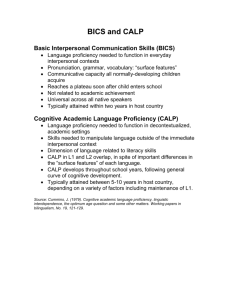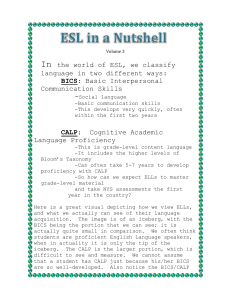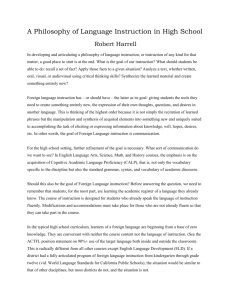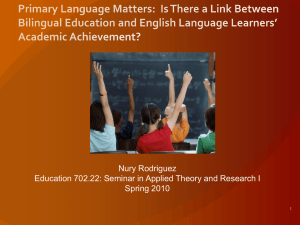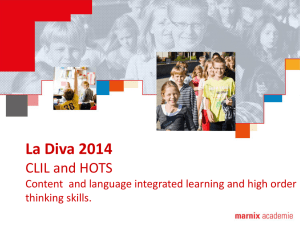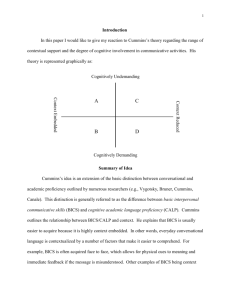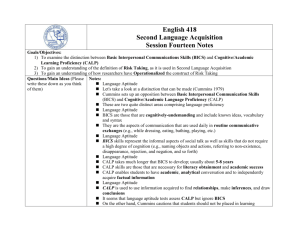Christian Putnam 4-13-08 EDUC 413
advertisement
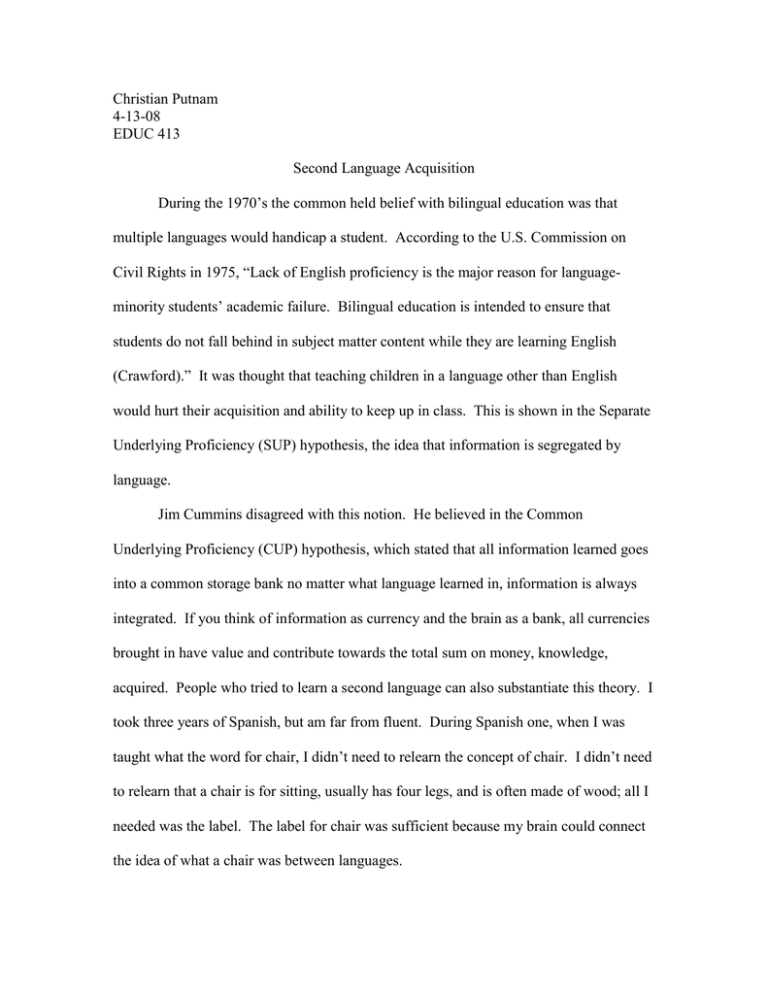
Christian Putnam 4-13-08 EDUC 413 Second Language Acquisition During the 1970’s the common held belief with bilingual education was that multiple languages would handicap a student. According to the U.S. Commission on Civil Rights in 1975, “Lack of English proficiency is the major reason for languageminority students’ academic failure. Bilingual education is intended to ensure that students do not fall behind in subject matter content while they are learning English (Crawford).” It was thought that teaching children in a language other than English would hurt their acquisition and ability to keep up in class. This is shown in the Separate Underlying Proficiency (SUP) hypothesis, the idea that information is segregated by language. Jim Cummins disagreed with this notion. He believed in the Common Underlying Proficiency (CUP) hypothesis, which stated that all information learned goes into a common storage bank no matter what language learned in, information is always integrated. If you think of information as currency and the brain as a bank, all currencies brought in have value and contribute towards the total sum on money, knowledge, acquired. People who tried to learn a second language can also substantiate this theory. I took three years of Spanish, but am far from fluent. During Spanish one, when I was taught what the word for chair, I didn’t need to relearn the concept of chair. I didn’t need to relearn that a chair is for sitting, usually has four legs, and is often made of wood; all I needed was the label. The label for chair was sufficient because my brain could connect the idea of what a chair was between languages. If Second Language Education is based on the Common Underlying Proficiency theory of Cummins, the best model is the late-exit program. In this type of program students spend the majority of their day being taught in their primary language, and a small portion taught in English. Year by year, the percentage of English taught increases, such as starting at 20% English in kindergarten and finishing with 80% English in 5th grade. This is harder to set up in higher grades because the students would have different language abilities, but is still doable especially with the help of pullout classes. This instruction model allows a student to acquire the academic knowledge expected, while acquiring English. Using Cummins’ theory, Late-exit would allow information to be learned and stored until the necessary English words were learned. This keeps a student from falling behind in content area while trying to acquire English. Late-exit instruction also incorporates Steven Krashen’s ideas on language acquisition. Krashen states that there are two types of language, Basic Interpersonal Communicative skills (BICS) and Cognitive Academic language proficiency (CALP). “BICS is the type of language used when having an average conversation. CALP is used when discussing cognitively demanding subject matter, classroom information (Leyba).” BICS is the type of language easily demonstrated and observed, but CALP is the type of language necessary to survive in school. The late-exit model allows a student to first develop their BICS and then CALP in English, while not missing out on material. The late-exit model allows a student to use the already developed CALP in their primary language to learn while having the time necessary to develop English CALP. As a student’s primary language CALP increases so does their secondary language CALP. The student needs only to learn the vocabulary necessary to verbalize their thoughts. This information on the theory of language acquisition and associated practices is useful for setting up my own classroom environment. It is imperative that I always remember that learning can happen in any language and allow the children to learn in any language. It would be great if I could teach in a late-exit style school, but that would be very difficult due to my lack of secondary language skills. Also, proposition 227 mandates classes must be taught in English. No Child Left Behind is completely based on test solely in English, which determine the abilities of the student and school. These two things combined make it tough for me to follow what the research says, so improvising is key. One way to battle these issues is to use other students as translators. If I can first find a way to teach concepts in any language I can then go back and provide the labels. Another thing is to try to find ways to relate topics to information the students already know. This will allow students to use their language skills to make connections with new material. To supplement my instruction, I can bring in non-English teaching materials such as textbooks or worksheets. This is also great in increasing parental involvement because parents can read these primary language texts. Lastly, it is crucial that I try to incorporate as many images as possible. The use of images is especially helpful for English beginners, those in quadrant one of Cummins’ quadrants. Cummins’ four quadrant “Are a relationship between the degree of cognitive involvement and the rang of contextual support (Genzuk).” If I had to predict if a non-English speaking student who had recently emigrated would succeed in school, I would observe a few factors. The first would be previous knowledge. As stated earlier, according to Cummins, if a student already understands a concept, the new label is all that must be learned. Krashen says this is also true for language, “If a students primary language is not used and supported there is a limiting effect on second language acquisition (Leyba).” The next factor would be motivation. As I have seen in my classroom observations, intelligence, without motivation means nothing. I have seen students who understand the material not do their work because they were unmotivated. These two factors can be related. A student I am currently working with in a math class seems to understand, but struggles when trying to solve word problems. He hasn’t associated words their mathematical definitions. He is fully aware of his struggle and has therefore started skipping school because he feels lost. To combat this in my classroom I need to find ways of showing students that they can do the work and not to let the language barrier get in their way. Also I need to provide motivation by making my class one students want to attend by putting math in context and providing a pleasurable learning environment. A student’s motivation should be intrinsic, but parental involvement is also a fundamental need for a student. Cummins theory of Cognitive Underlying Proficiency has provided the framework for teaching English language learners. Because all learned information is stored together, despite the language it was learned in, late-exit is the best model for educating English language learners. This is backed up by the work of Krashen and his segmentation of language in conversational and academic parts. These theories provide me with the ways to set up my own classroom. The emigrant students, who are mostly to succeed, are the one with large amounts of previous knowledge, high intrinsic motivation and high parental involvement.
